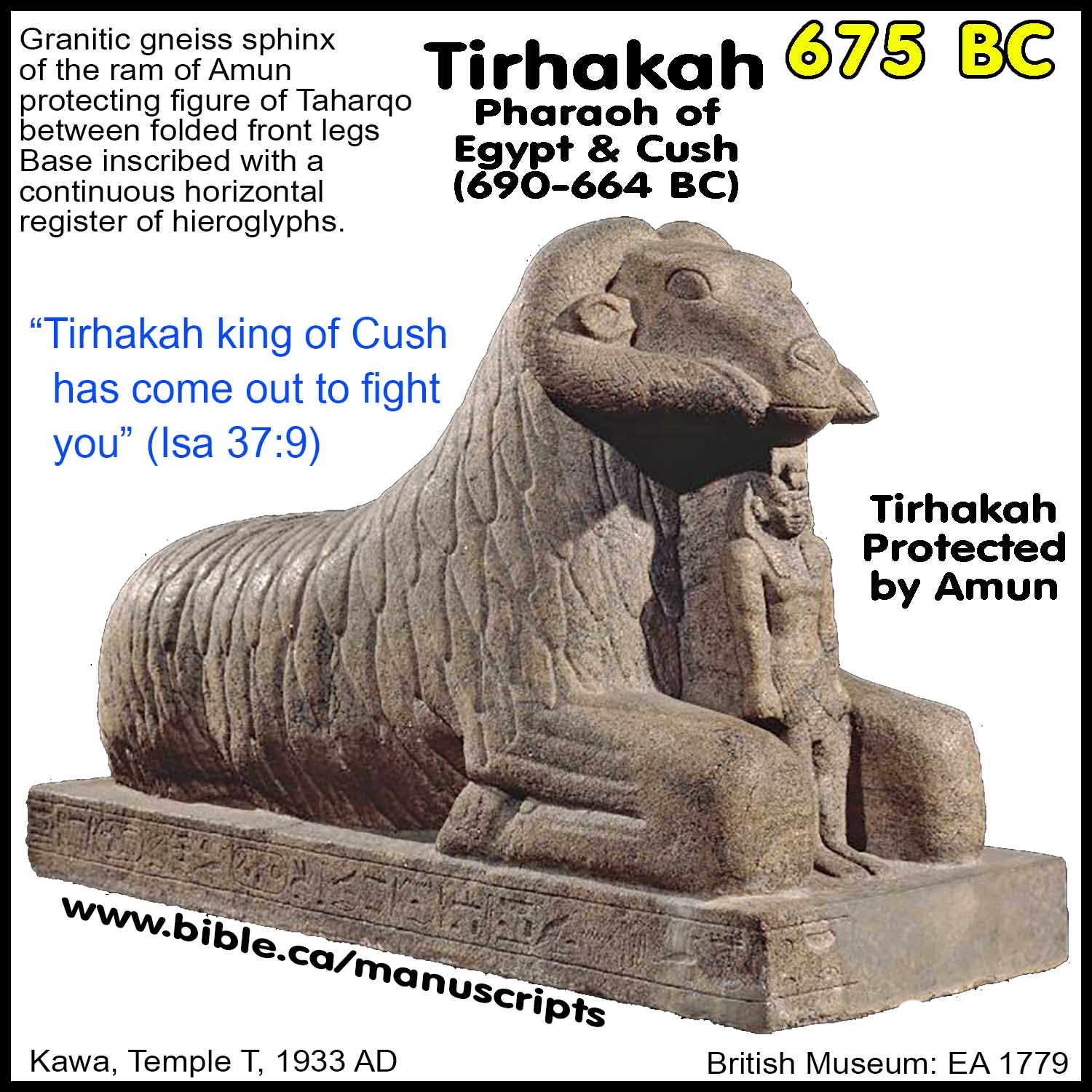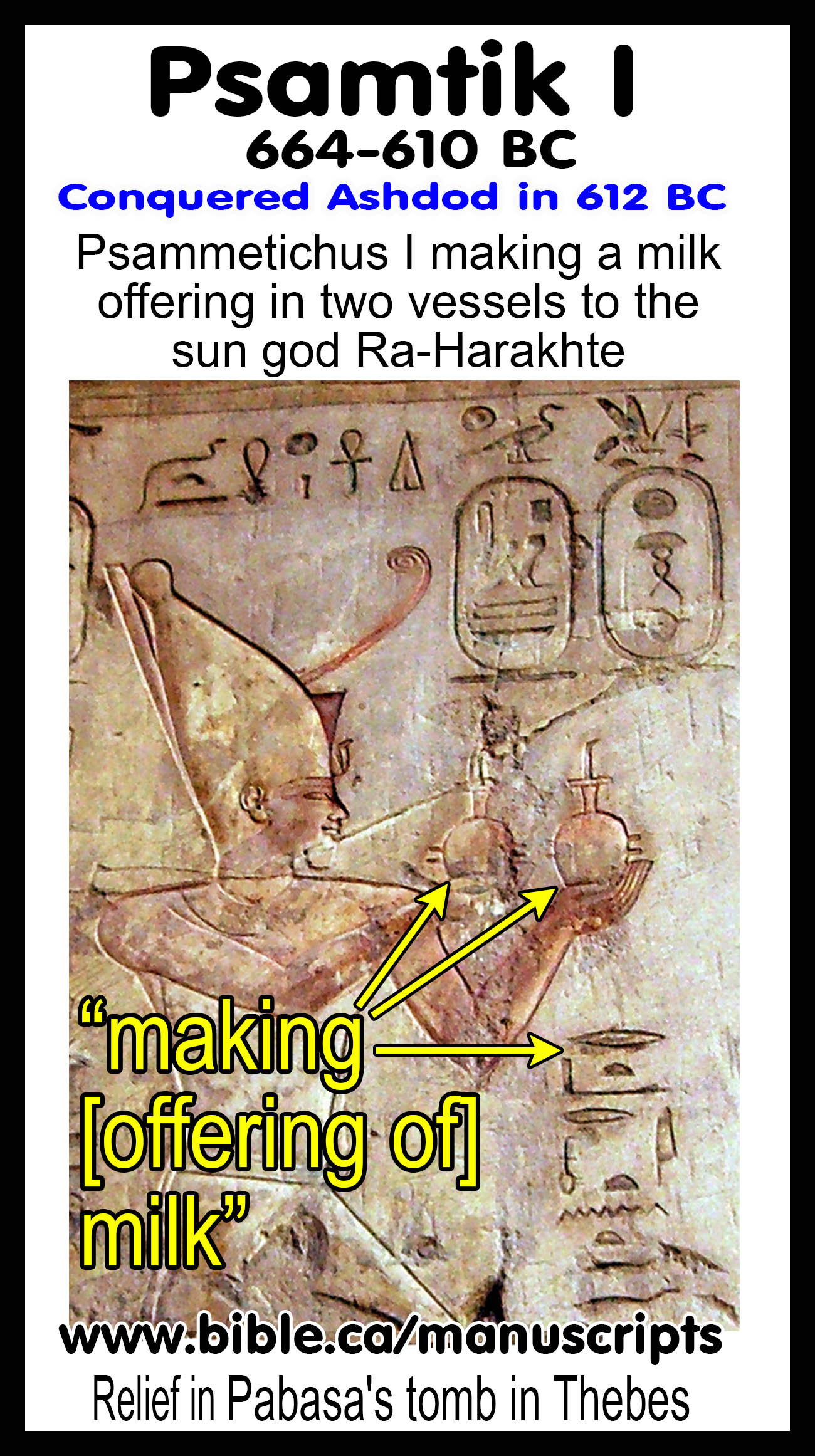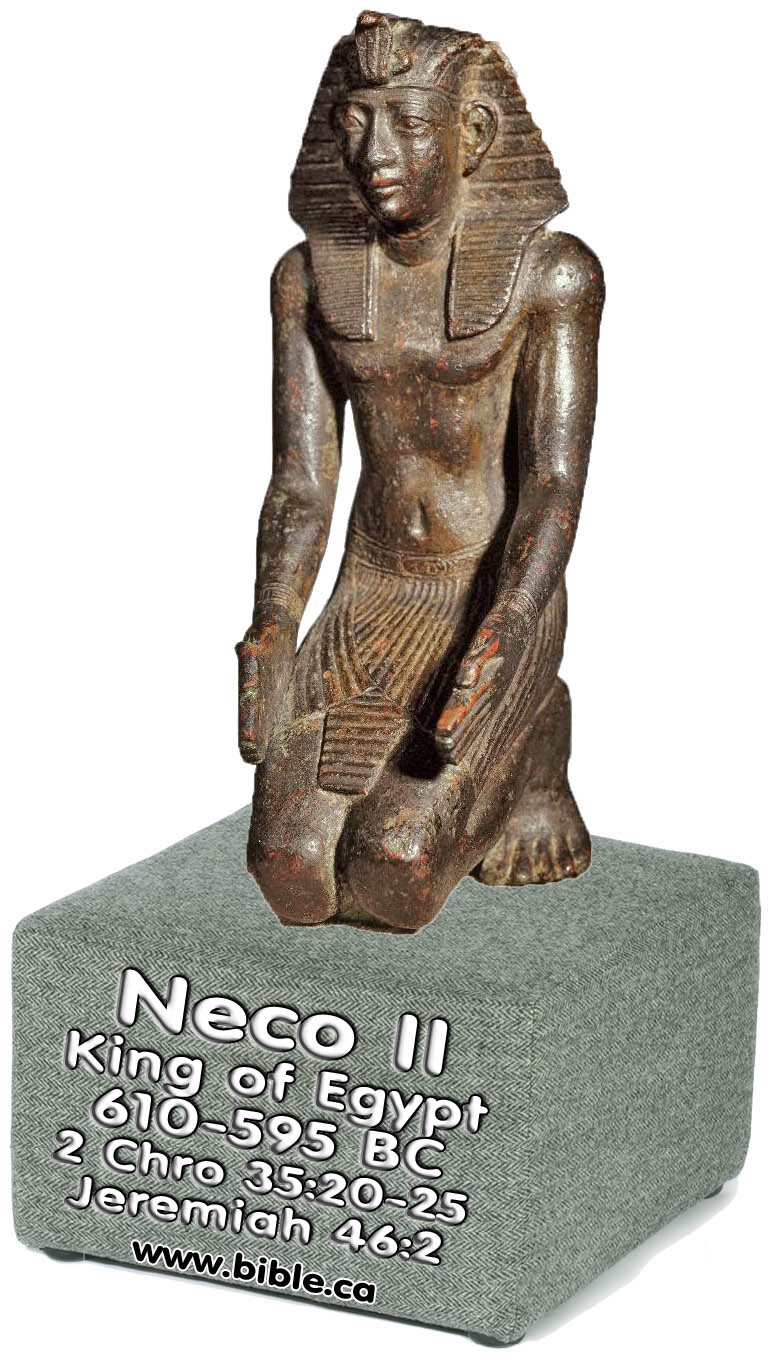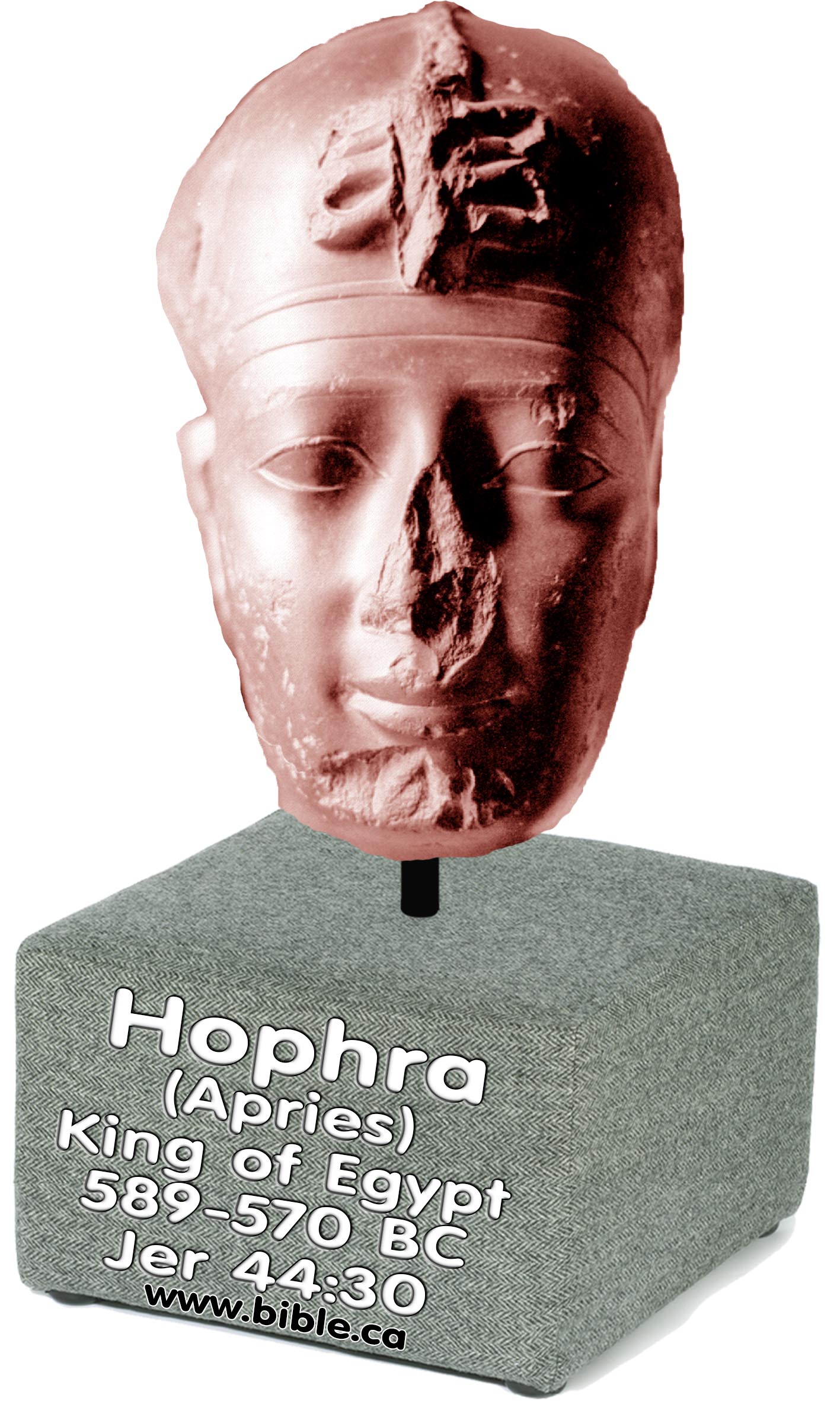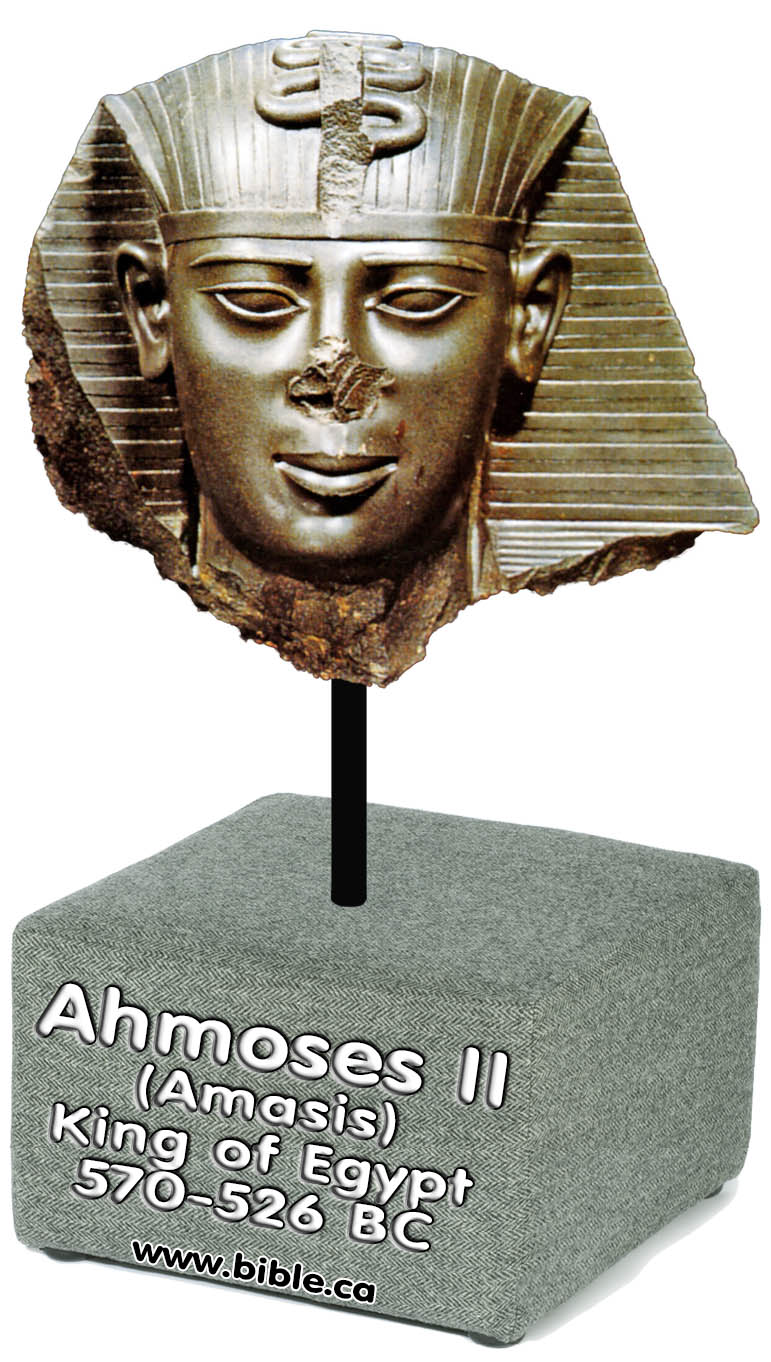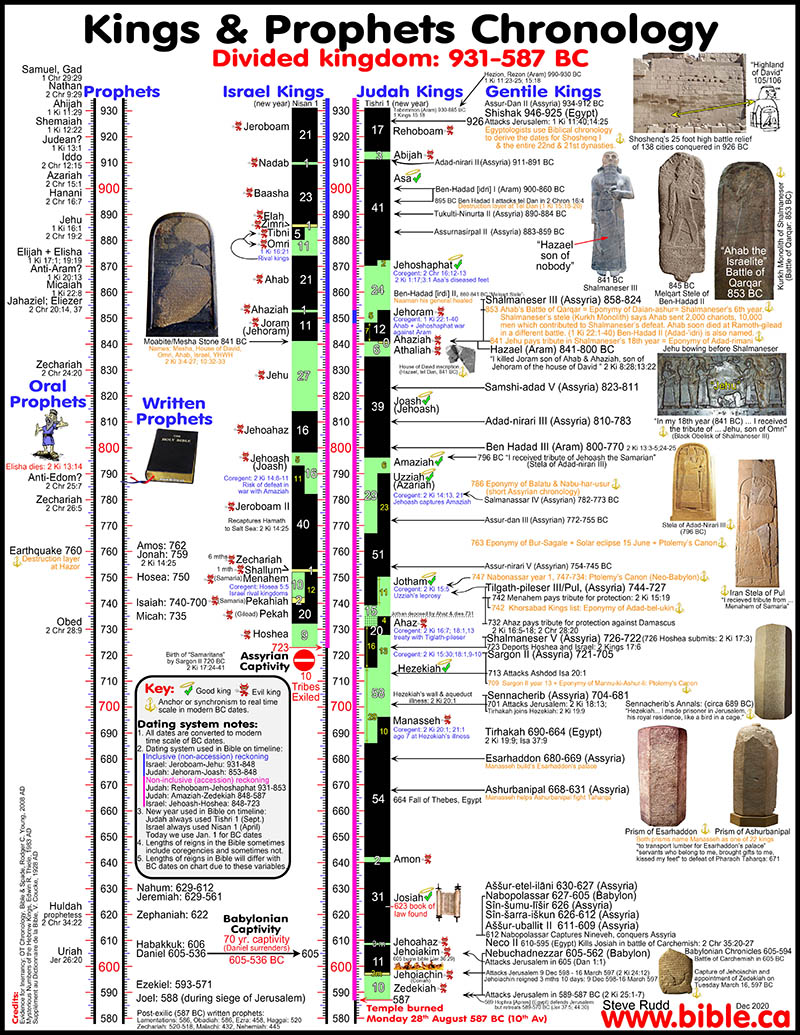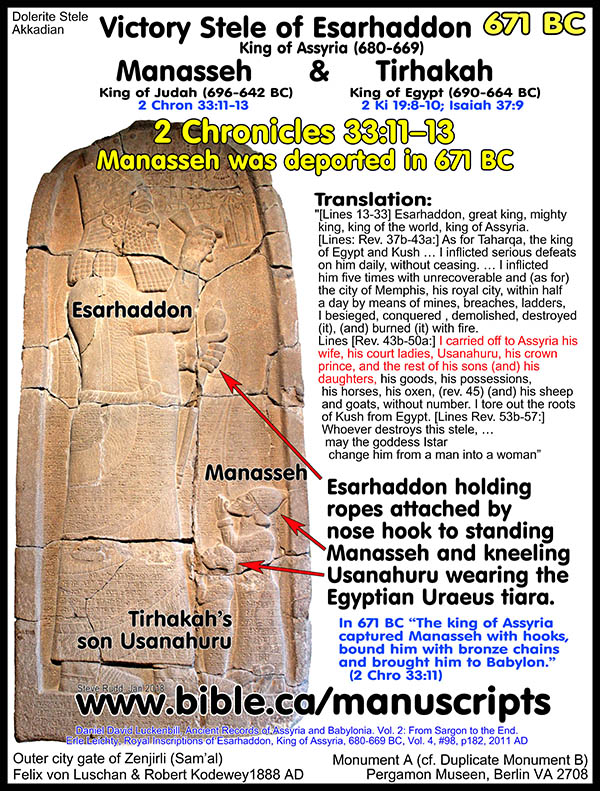Egyptian Pharaohs of the Babylonian Captivity: 690-570 BC
|
. |
EGYPT: Tirhakah | Psamtik I | Neco II | Psamtik II | Hophra | Amesis II |
JUDAH: Manasseh | Josiah | Jehoiakim| Zedekiah | Gedaliah
ASSYRIA: Sennacherib | Esarhhaddon| Ashurbanipal
BABYLON: Nabopolassar | Nebuchadnezzar
|
25th Dynasty Egyptian Pharaohs |
||||
|
Tirhakah (Taharqa) |
|
|
|
|
|
690-664 BC |
|
|
|
|
|
|
|
|
|
|
|
26th Dynasty Egyptian Pharaohs |
||||
|
Psamtik I (Psammetichus I) |
Neco II |
Psamtik II (Psammetichus II) |
Hophra (Apries) |
Amasis II (Amoses) |
|
664-610 BC |
610-595 BC |
595-589 BC |
589-570 BC |
570-526 BC |
|
Digging up Bible stories! The
five Egyptian Pharaohs of the See also: 1. Josiah the chosen one: 640-609 BC 2. Jehoiakim the bible burner: 609-598 BC 3. Zedekiah the last hope: 597-587 BC What you read in the book you find in the ground! |
Introduction:
- This is a chronological outline of Egyptian Pharaoh’s as it relates to the Bible which is organized by date.
- In the 7th century BC, Judea was caught between Egypt and Assyria.
- All Manasseh needed to do was turn to God with all his heart and neither nation would have been a threat.
- In 671 and 667 BC, Manasseh, King of Judah, helped Assyria (Ashurbanipal I) fight Egypt (Taharqa) and Ethiopia (Nubia).
- It is likely that Manasseh established the outpost at Elephantine in 667 BC in rebellion to Egypt’s king Taharqa (Tirhakah) (690 - 664 BC).
- After the death of Pharaoh Taharqa (Tirhakah) in 664 BC, his son Psamtik I (664-610 BC).
- Catalogue of Pharaohs:
- 25th Dynasty:
i. 690-664 BC: Taharqa (Tirhakah)
- 26th Dynasty: The Five Egyptian Pharaohs of the Babylonian Captivity: 664-570 BC
i. 664-610 BC: Psamtik I (Psammetichus I). founder of the 26th dynasty.
ii. 610-595 BC: Neco II
iii. 595-589 BC: Psamtik II (Psammetichus II)
iv. 589-570 BC: Hophra (Apries)
v. 570-526 BC: Amasis II (Amoses)
3. Manasseh, King of Judah (695-642 BC)
a. Main story where Manasseh was the most wicked king of Judah: 2 Chron 33:1-10; 2 Kings 21:1-10
b. Manasseh was captured by : 2 Chronicles 33:11-20
c.
Manasseh is named in two different Assyrian kings prisms
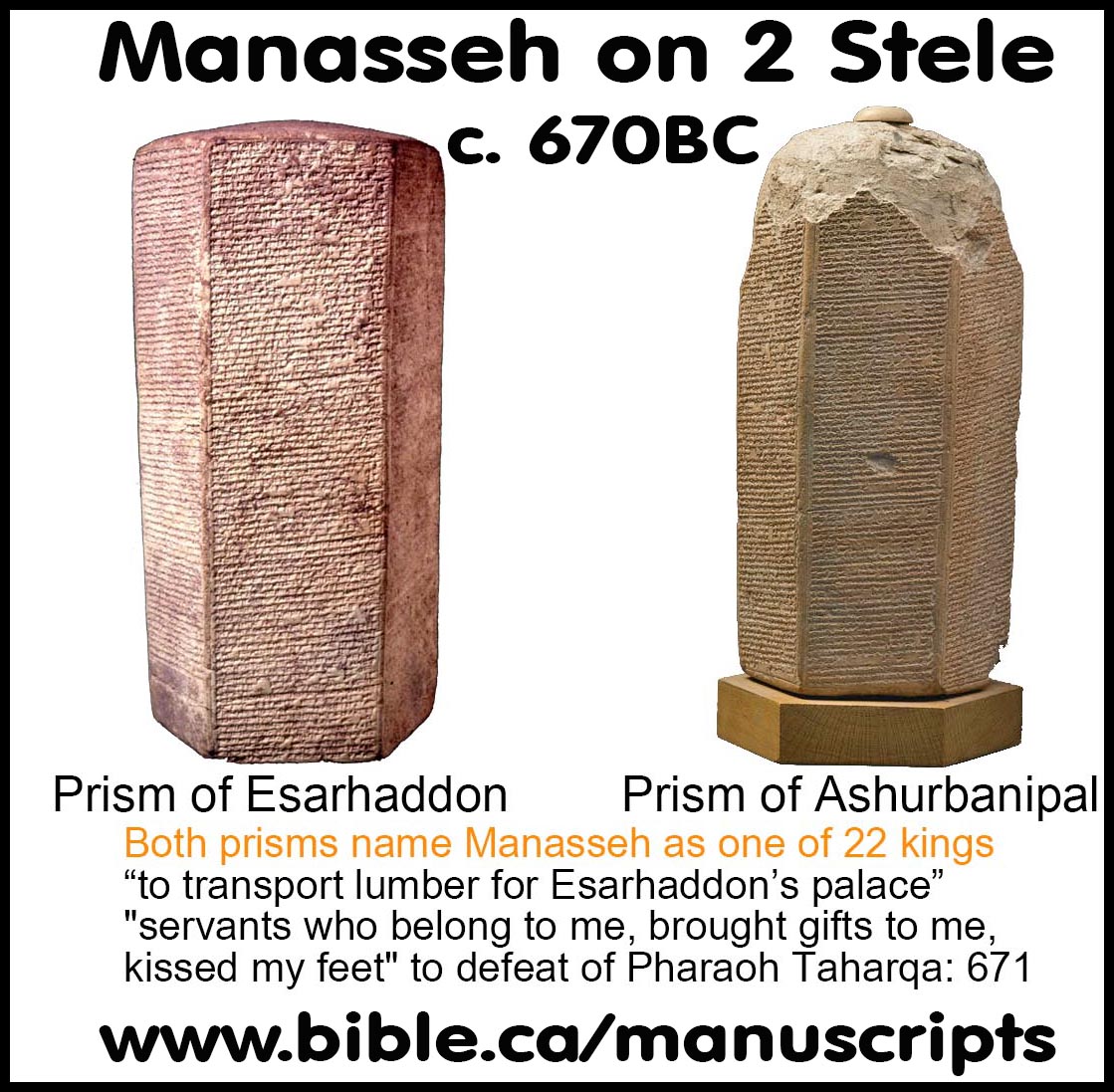
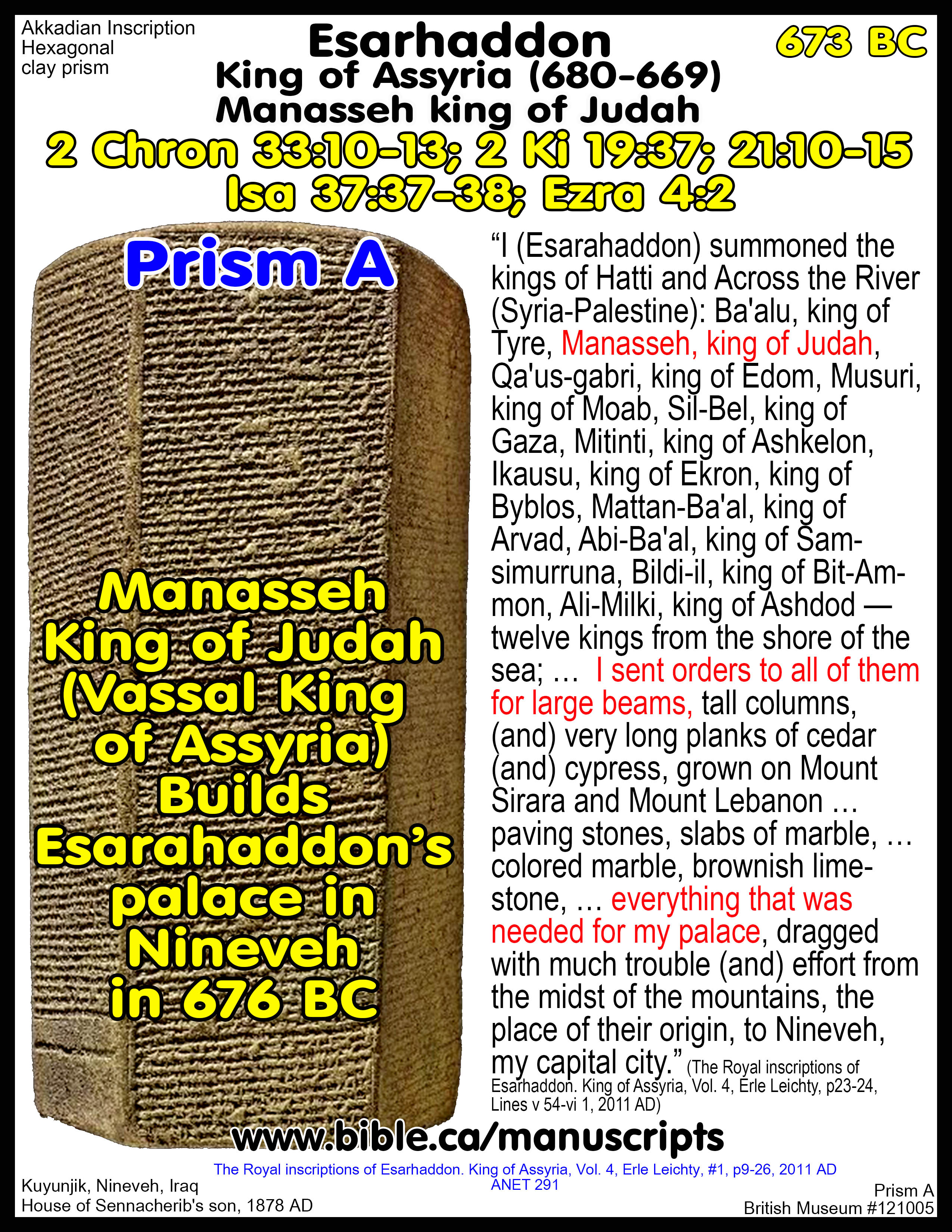
4. Deported
with fishhooks in Jaw:
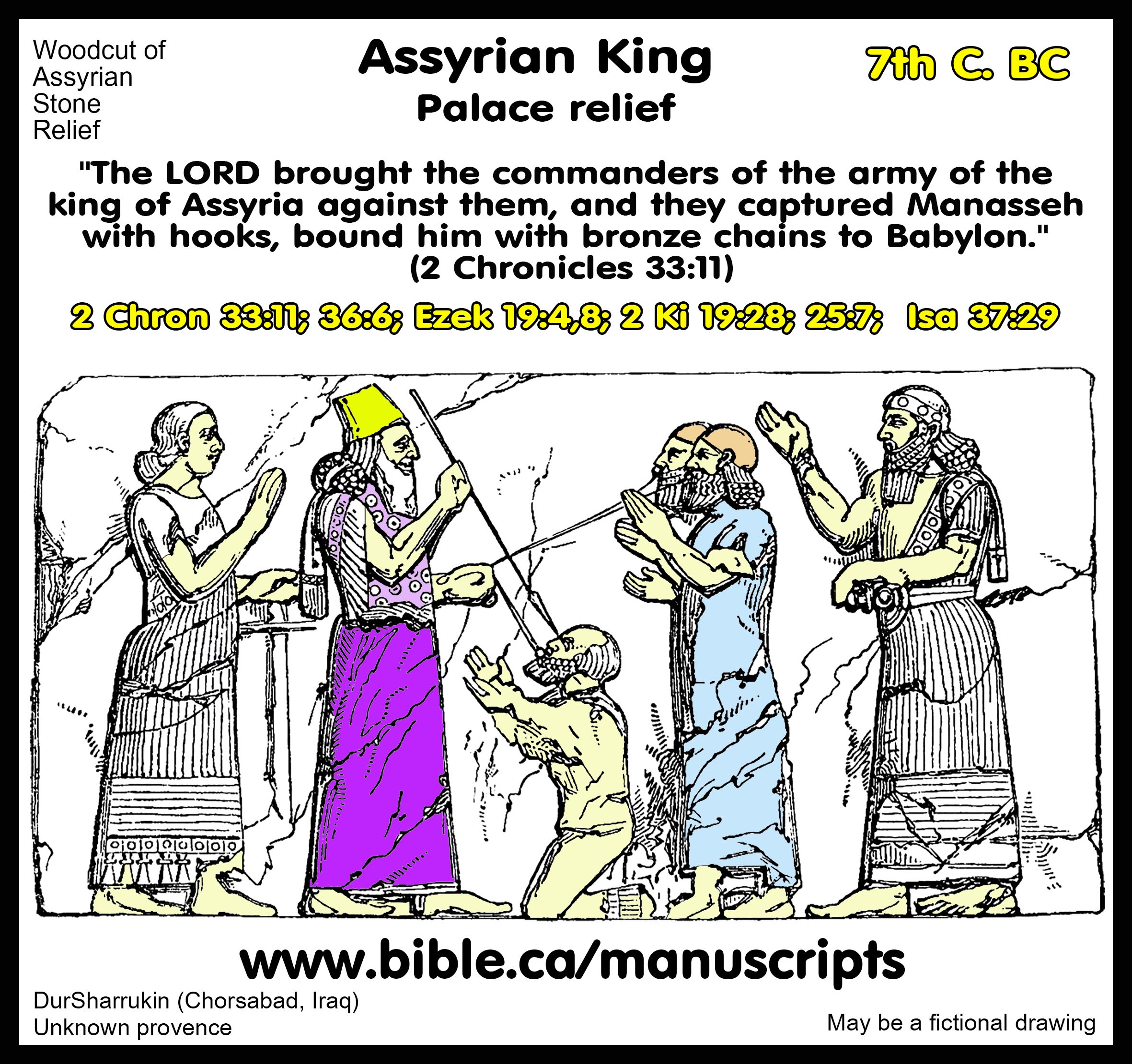
a. “Yet another suggestion is that the reference is to the method of carrying fish, with a line through their jaws (illustration: J. Gardner Wilkinson, The Manners and Customs of the Ancient Egyptians [London: John Murray, 1878] 2:118, fig. 373), or of keeping caught fish alive by passing a cord through their gills and returning them to the water (Dalman, Arbeit und Sitte, 8:338, 360). Or the image may be of the treatment of captives in war; a famous stele of Esarhaddon, for example, shows two of his captives, Tirhakah (Taharka), the Egyptian king, and Ba‘lu, king of Tyre, with rings through their lips, attached to a cord that Esarhaddon holds in his left hand (ANEP, fig. 447). From Egypt, a depiction of King Narmer shows a prisoner attached by a rope through his nose (ANEP, fig. 296). Similarly in the Mesopotamian creation epic Enuma elish, the god Ea lays hold of his captive Mummu, “holding him by the nose-rope” (ANET, 61b, line 72).” (World Biblical commentary, Job 41:1)
b. Manasseh was bound in bronze shackles and taken to Babylon: "Therefore the LORD brought the commanders of the army of the king of Assyria against them, and they captured Manasseh with hooks, bound him with bronze chains and took him to Babylon." (2 Chronicles 33:11)
c.
1177 BC: Philistines deported to Egypt in shackles
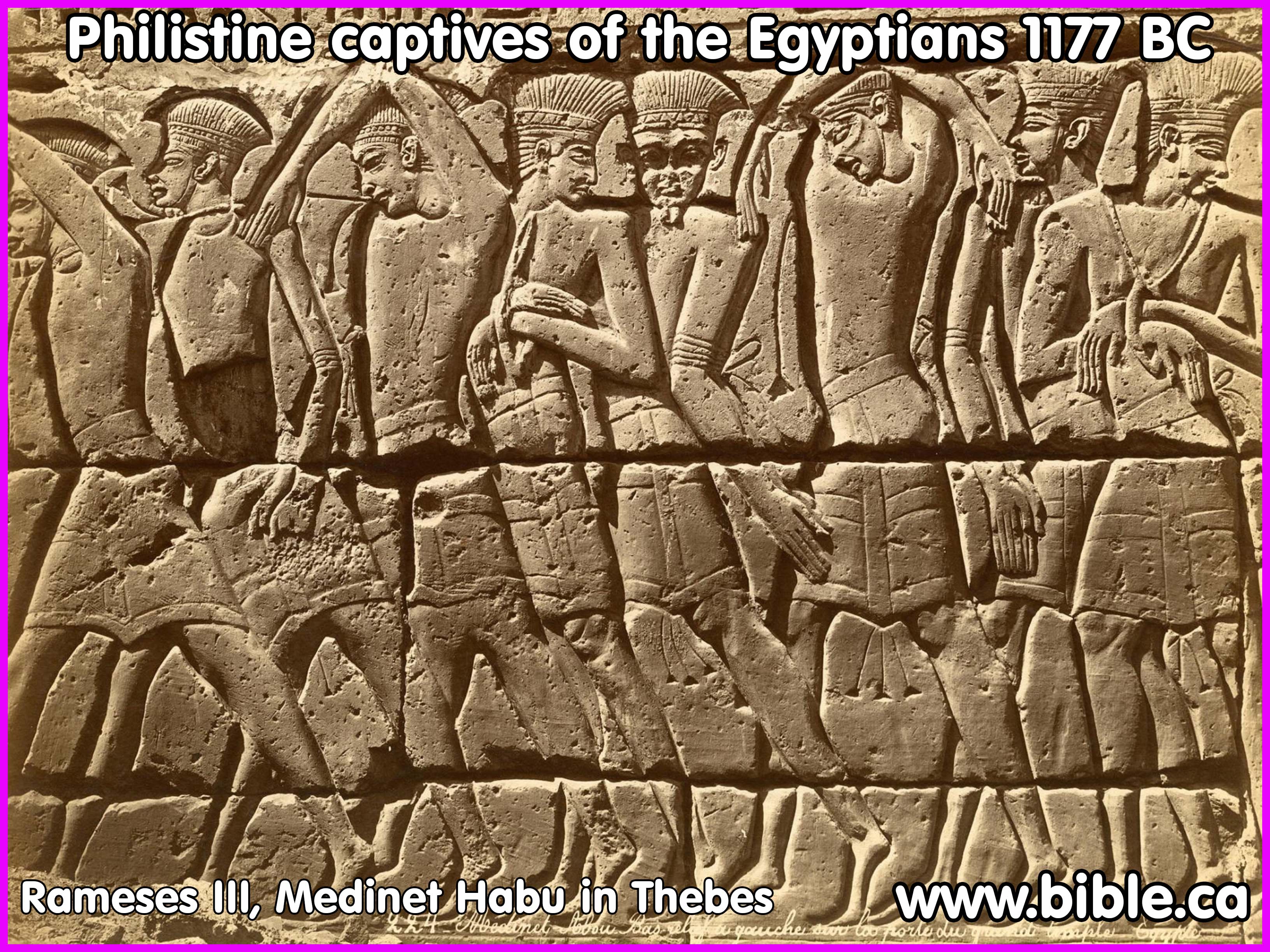
d. God told Hezekiah that Sennacherib would not attack Jerusalem but metaphorically be taken back to his own country of Assyria in fishhooks. "‘Because of your raging against Me, And because your arrogance has come up to My ears, Therefore I will put My hook in your nose, And My bridle in your lips, And I will turn you back by the way which you came." (2 Kings 19:28)
e. On Monday 17 Sept 592 BC, Ezekiel said Judah would be deported to Egypt and Babylon in hooks: "‘Then nations heard about him; He was captured in their pit, And they brought him with hooks To the land of Egypt." (Ezekiel 19:4) "‘They put him in a cage with hooks And brought him to the king of Babylon; They brought him in hunting nets So that his voice would be heard no more On the mountains of Israel." (Ezekiel 19:9)
f. Jehoiakim bound in bronze shackles and taken to Babylon: "Nebuchadnezzar king of Babylon came up against him and bound him with bronze chains to take him to Babylon." (2 Chronicles 36:6)
5. See other outlines on Judean Kings:
a. Josiah the chosen one: 640-609 BC
b. Jehoiakim the bible burner: 609-598 BC
c. Zedekiah the last hope: 597-587 BC
The Six Egyptian Pharaohs of the Babylonian Captivity: 664-570 BC
|
|
|
|
Tirhakah (Taharqa): 690-664 BC Amun (or Amon) was the patron deity of Thebes, eventually being recognized as Egypt's "king of the gods." Here he is pictured as a ram accompanied by Tirhakah, King of Cush (2 Kgs 19:9). Jeremiah prophesied the destruction of Amon at the hands of Nebuchadnezzar (Jer 46:25). |
|
- Bible verses:
- 701 BC: "Then Rabshakeh returned and found the king of Assyria [Sennacherib] fighting against Libnah, for he had heard that the king had left Lachish. When he heard them say concerning Tirhakah king of Cush, “Behold, he has come out to fight against you [Sennacherib],” he sent messengers again to Hezekiah saying, “Thus you shall say to Hezekiah king of Judah, ‘Do not let your God in whom you trust deceive you saying [since it appeared to Sennacherib that Egypt was helping Hezekiah], “Jerusalem will not be given into the hand of the king of Assyria.”" (2 Kings 19:8–10; Isaiah 37:9, 701 BC)
- Last king of the 25th Dynasty: Tirhakah (Taharqa) was pharaoh 690 - 664 BC
a. 690-664 BC: Tirhakah (Taharqa)
- This was a time when Egypt was divided with multiple kings in different geographical areas.
- In 671 BC Esarhaddon (680-669 BC) invaded Egypt but not Judea:
- At this time, Manasseh (Judea) was a vassal state in submission to Assyria and therefore did not get invaded.
- “Fragmentary inscription of Esarhaddon (680-669 BC). The text reports reprisals against Phoenician and Philistine cities which had apparently joined an anti-Assyrian conspiracy with the Egyptian king Tarqu (Tarhaqa). The inscription refers to twenty-two western kings who were subdued during Esarhaddon’s campaign to Egypt (671 b.c.e.), but unfortunately the tablet is broken where the names of the rebellious rulers were probably listed. Manasseh may have joined this rebellion” (ABD, Manasseh, King of Judah)
- 671 AD military campaign archeological Stele of Esarhaddon: “I cut down with the sword and conquered … I caught like a fish (and) cut off his head. I trod up[on Arzâ at] the “Brook of Eg[ypt].” I put Asuhili, its king, in fetters and took [him to Assyria]. I conquered the town of Bazu in a district which is far away. Upon Qanaia, king of Tilmun. I imposed tribute due to me as (his) lord. I conquered the country of Shupria in its full extent and slew with (my own) weapon Ik(!)-Teshup, its king who did not listen to my personal orders. I conquered Tyre which is (an island) amidst the sea. I took away all the towns and the possessions of Ba’lu its king, who had put his trust on Tirhakah (Tarqű), king of Nubia (Kűsu). I conquered Egypt (Muṣur), Paturi[si] and Nubia. Its king, Tirhakah, I wounded five times with arrowshots and ruled over his entire country; I car[ried much booty away]. All the kings from (the islands) amidst the sea—from the country Iadanana (Cyprus), as far as Tarsisi, bowed to my feet and I received heavy tribute (from them).” (ANET 290, 2–11 obverse)
3. Victory Stele of Esarhaddon: 671 BC (King of Assyria 680-669)
a. See also Detailed outline on the Victory Stele of Esarhaddon
b. The victory Stele of Esarhaddon dates to 671 BC which is contemporary with Manasseh, king of Judah (695-642 BC) Several scriptures speak of Assyrian kings deporting Judeans with ropes attached to lip hooks and shackles.
c. Here is a stele that has Taharqa (Egyptian Pharaoh) kneeling before Esarhaddon with a rope attached to a nose ring.
d. Standing is Baal I, King of Tyre. At this time in history Manasseh was allied with Assyria against Egypt but that would change when Taharqa dies.
|
Victory Stele of Esarhaddon: 671 BC "[Lines 13-33] Esarhaddon, great king, mighty king, king of the world, king of Assyria. [Lines: Rev. 37b-43a:] As for Taharqa, the king of Egypt and Kush … I inflicted serious defeats on him daily, without ceasing. … I inflicted him five times with unrecoverable and (as for) the city of Memphis, his royal city, within half a day by means of mines, breaches, ladders, I besieged, conquered, demolished, destroyed (it), (and) burned (it) with fire. Lines [Rev. 43b-50a:] I carried off to Assyria his wife, his court ladies, Usanahuru, his crown prince, and the rest of his sons (and) his daughters, his goods, his possessions, his horses, his oxen, (rev. 45) (and) his sheep and goats, without number. I tore out the roots of Kush from Egypt. [Lines Rev. 53b-57:] Whoever destroys this stele, … may the goddess Istar change him from a man into a woman” |
- In 667 BC Manasseh sent troops to help Ashurbanipal king of Assyria fight Egypt's pharaoh Tirhakah (Taharqa).
- Tirhakah was defeated by Assyria with Manasseh’s help.
- “Second Chronicles 33:11–16 indicates that he was taken as a prisoner of war to Babylon, that he genuinely repented there, that God restored him as king, and that he tried to abolish his former pagan practices and to restore proper worship of God alone. Skepticism about this account is not warranted, even though unparalleled in 2 Kings. Surviving Assyrian records twice mention Manasseh, saying that he faithfully provided men to transport timber from Lebanon to Nineveh for the Assyrian king Esar-haddon (681–669 bc) and that he paid tribute to King Ashurbanipal (669–627 bc) after an Assyrian military campaign in Egypt in 667 bc.” (Tyndale Bible dictionary, Manasseh)
- Elephantine established in 667 BC by Manasseh as a Jewish outpost: See also Elephantine Papyri. The Elephantine Temple papyri say that the Persian ruler Cambyses conquered Egypt in 525 BC, that he saw the temple standing. It may never be know for certain but the most likely scenario based upon the Bible, history, the archeological dig reports and the papyrus, Elephantine was founded as a Jewish colony by Manasseh either in 667 and that the YHWH temple was built with ten years of the decree of Cyrus in 536 BC.
- After Tirhakah died in 664 BC, Manasseh switched alliances and sided with Egypt (Psamtik I) and rebelled against Assyria.
- 667 AD military campaign archeological Stele of Ashurbanipal (668-631 BC): (Prism E 10, 13–21; Prism C II 37–67): "In my first campaign [667 BC] I [Ashurbanipal] marched against Egypt (Magan) and Ethiopia (Meluhha). Tirhakah (Tarqű), king of Egypt (Muṣur) and Nubia (Kűsu), whom Esarhaddon, king of Assyria, my own father, had defeated and in whose country he (Esarhaddon) had ruled, this (same) Tirhakah forgot the might of Ashur, Ishtar and the (other) great gods, my lords, and put his trust upon his own power. He turned against the kings (and) regents whom my own father had appointed in Egypt.3 He entered and took residence in Memphis (Me-im-pi), the city which my own father had conquered and incorporated into Assyrian territory. An express messenger came to Nineveh to report to me. I became very angry on account of these happenings, my soul was aflame. I lifted my hands, prayed to Ashur and to the Assyrian Ishtar. (Then) I called up my mighty armed forces which Ashur and Ishtar have entrusted to me and took the shortest (lit.: straight) road to Egypt (Muṣur) and Nubia. During my march (to Egypt) 22 kings from the seashore, the islands and the mainland, … Ba’al, king of Tyre, Manasseh (Mi-in-si-e), king of Judah (Ia-ú-di), Qaushgabri, king of Edom, Musuri, king of Moab, Sil-Bel, king of Gaza, Mitinti, king of Ashkelon, Ikausu, king of Ekron, Milkiashapa, king of Byblos, Iakinlu, king of Arvad, AbiBa’al, king of Samsimuruna, Amminadbi, king of Beth-Ammon, Ahumilki, king of Ashdod, Ekishtura, king of Edi’li, Pilagura, king of Pitrusi, Kisu, king of Silua, Ituandar, king of Pappa, Erisu, king of Sillu, Damasu, king of Kuri, Admesu, king of Tamesu, Damusu, king of Qarti-hadasti, Unasagusu, king of Lidir, Pususu, king of Nure, together 12 kings from the seashore, the islands and the mainland … servants who belong to me, brought heavy gifts (tâmartu) to me and kissed my feet. I made these kings accompany my army over the land—as well as (over) the sea-route with their armed forces and their ships (respectively). Quickly I advanced as far as Kar-Baniti to bring speedy relief to the kings and regents in Egypt, servants who belong to me. Tirhakah, king of Egypt (Muṣur) and Nubia, heard in Memphis of the coming of my expedition and he called up his warriors for a decisive battle against me. Upon a trust (-inspiring) oracle (given) by Ashur, Bel, Nebo, the great gods, my lords, who (always) march at my side, I defeated the battle(-experienced) soldiers of his army in a great open battle. Tirhakah heard in Memphis of the defeat of his army (and) the (terror-inspiring) splendor of Ashur and Ishtar blinded (lit.: overwhelmed) him (thus) that he became like a madman. The glamor of my kingship with which the gods of heaven and nether world have endowed me, dazzled him and he left Memphis and fled, to save his life, into the town Ni’ (Thebes). This town (too) I seized and led my army into it to repose (there)." (Ashurbanipal’s first campaign in 667 BC, ANET 294)
|
|
|
|
Psamtik I (Psammetichus I): 664-610 BC 1. There are several archeological confirmations of Psamtik II. a. Relief found in the tomb of Pabasa in Thebes, Egypt i. Psamtik I is pictured making an offering to the sun god Ra-Harakhte holding two vessels filled with milk. ii. The hieroglyphic text beneath his hands says, "making [offering of] milk". b. Herodotus Hist. 2.29.2–30.5 records he had three outposts at: Elephantine, Daphnae and Marea. |
|
2. In 655 BC Psammetichus I defeats Nubia (Ethiopians) with the help of Manasseh, and declares independence from Assyria.
3. Although Elephantine was founded by Manasseh in 667 BC as a military outpost when he sent troops to help Ashurbanipal I (Assyria), it was greatly expanded by Manasseh in 655 BC when Manasseh joined Pharaoh Psammetichus to defeat Nubia and both declared independence from Assyria.
a. See also Elephantine Papyri
a. "Psammetichus I (664–610), with the help of Gyges, king of Lydia, rebelled against Assyria in 655 b.c.e. The constant threat from Assyria might have led the pharaoh to authorize Manasseh to improve his fortifications and redeploy his troops (2 Chr 33:11–14) so that Judah could serve as a buffer state between Egypt and Assyria." (Hermeneia, 2 Chronicles 33:21-25, 2012 AD)
b. "The Jewish community at Elephantine was probably founded [or expanded] as a military installation in about 650 B.C.E. during Manasseh’s reign. A fair implication from the historical documents, including the Bible, is that Manasseh sent a contingent of Jewish soldiers to assist Pharaoh Psammetichus I (664-610 B.C.E.) in his Nubian campaign and to join Psammetichus in throwing off the yoke of Assyria, then the world superpower. Egypt gained independence, but Manasseh’s revolt failed; the Jewish soldiers, however, remained in Egypt. Herodotus reports that in the reign of Psammetichus I, garrisons were posted at Elephantine, Daphnae and Marea. Perhaps as an accommodation to the Jews in Egypt who served as a buffer to renewed Assyrian control of Syro-Palestine (and also to consolidate their loyalty), Psammetichus permitted the Jews to build their temple. The Jews were not the only ones to benefit. The Aramean soldiers on the mainland at Aswan were also allowed to erect temples to their gods—Banit, Bethel, Nabu and the Queen of Heaven. (Did the Ark Stop at Elephantine?, Bezalel Porten, BAR, BAR 21:03, May/June, 1995 AD)
c. "According to Porten, the temple was established by priests from Jerusalem who had gone into self-imposed exile in Egypt during the reign of King Manasseh (c. 650 B.C.E.) to establish a purer Yahwistic temple there." (Ancient Israel, Exile and Return: From the Babylonian Destruction to the Reconstruction of the Jewish State, James D. Purvis, Eric M. Meyers, Biblical Archaeology Society, 2004 AD)
d. "Porten suggested that the Jews may have come to Elephantine as a military garrison in about the middle of the seventh century bce, during the reign of Manasseh in Judah, to aid Psammetichus I in his campaigns against Nubia (cf. Lewy and Lewy 1968: 135) and in an attempt to dislodge the overarching power of Assyria (Porten 1968: 119)." (Near Eastern Archaeology, Volume 67, Nos. 1–4, p 6, 2004 AD)
4. “Beyond Elephantine, as one travels inland, the land rises. Here one must pass with the boat roped on both sides as men harness an ox; and if the rope breaks, the boat will be carried away by the strength of the current. [3] This part of the river is a four days’ journey by boat, and the Nile here is twisty just as the Maeander; a distance of twelve schoeni must be passed in the foregoing manner. After that, you come to a level plain, where there is an island in the Nile, called Takhompso. [4] The country above Elephantine now begins to be inhabited by Ethiopians: half the people of the island are Ethiopians, and half Egyptians. Near the island is a great lake, on whose shores live nomadic Ethiopians. After crossing this, you come to the stream of the Nile, which empties into this lake. [5] Then you disembark and journey along the river bank for forty days; for there are sharp projecting rocks in the Nile and many reefs, through which no boat can pass. [6] Having traversed this part in forty days as I have said, you take boat again and so travel for twelve days until you come to a great city called Meroe, which is said to be the capital of all Ethiopia. [7] The people of the place worship no other gods but Zeus and Dionysus; these they greatly honor, and they have a place of divination sacred to Zeus; they send out armies whenever and wherever this god through his oracle commands them. [30] [1] From this city you make a journey by water equal in distance to that by which you came from Elephantine to the capital city of Ethiopia, and you come to the land of the Deserters. These Deserters are called Asmakh, which translates, in Greek, as “those who stand on the left hand of the king”. [2] These once revolted and joined themselves to the Ethiopians, two hundred and forty thousand Egyptians of fighting age. The reason was as follows. In the reign of Psammetichus [Psammetichus I], there were watchposts at Elephantine facing Ethiopia, at Daphnae of Pelusium facing Arabia and Assyria, and at Marea facing Libya. [3] And still in my time the Persians hold these posts as they were held in the days of Psammetichus [Psammetichus I]; there are Persian guards at Elephantine and at Daphnae. Now the Egyptians had been on guard for three years, and no one came to relieve them; so, organizing and making common cause, they revolted from Psammetichus and went to Ethiopia. [4] Psammetichus heard of it and pursued them; and when he overtook them, he asked them in a long speech not to desert their children and wives and the gods of their fathers. Then one of them, the story goes, pointed to his genitals and said that wherever that was, they would have wives and children. [5] So they came to Ethiopia, and gave themselves up to the king of the country; who, to make them a gift in return, told them to dispossess certain Ethiopians with whom he was feuding, and occupy their land. These Ethiopians then learned Egyptian customs and have become milder-mannered by intermixture with the Egyptians. (Herodotus Hist. 2.29.2–30.5)
5. 610 BC: Psamtik’s last days
a. Psamtik I conquers Ashdod.
b. Psamtik I dies.
|
|
|
|
Neco II: 664-610 BC 1. 609 BC: God communicates directly with Neco II and was the servant of YHWH. a. Battle at Carchemish between Neco II, Josiah and Nebuchadnezzar. Neco II withdrew from Carchemish to Megiddo where he killed Josiah. (2 Ki 23:29-30; 2 Chron 35:20-27). b. God spoke directly to Neco II and was with him in his battles. Neco II warned Josiah he was on a mission from God after Battle of Carchemish. c. Neco II kills Josiah at Megiddo: 2 Chron 35:20-27; 2 Kings 23:28-29; 2 Kings 23:30-37; 2 Chron 36:1-5 |
|
d. Josiah simply did not believe that God would actually work with a non-Jewish pagan king and it cost him his life!
e. Later Nebuchanezzar would be called the "Servant" of YHWH: “Now I have given all these lands into the hand of Nebuchadnezzar king of Babylon, My servant, and I have given him also the wild animals of the field to serve him. “All the nations shall serve him and his son and his grandson until the time of his own land comes; then many nations and great kings will make him their servant. “It will be, that the nation or the kingdom which will not serve him, Nebuchadnezzar king of Babylon, and which will not put its neck under the yoke of the king of Babylon, I will punish that nation with the sword, with famine and with pestilence,” declares the Lord, “until I have destroyed it by his hand." (Jeremiah 27:6-8)
f. Neco II disposes Jehoahaz and deports him first to Riblah, then to Egypt where he dies: 2 Chronicles 36:3–5; Jer 22:1-12 (spoken in 687 BC)
g. Neco II appoints Jehoiakim king of Judah who pay tribute to Neco II. 2 Chron 36:1-5; Jer 22:1-12 (spoken in 587 BC)
2. 607 BC: Nabopolassar subdues Egypt (Neco II), Hamath Phoenicia and Judea.
a. Nabopolassar appoints a governor over Egypt which probably was Neco II who became a vassal king.
b. By subjecting Egypt (Neco II) he automatically controlled Judah and Jehoiakim without any literal invasion. Jehoiakim's submission changes from Egypt to Babylon.
c. "(219) Now when king Nebuchadnezzar had reigned forty-three years, he ended his life. He was an active man, and more fortunate than the kings that were before him. Now Berosus makes mention of his actions in the third book of his Chaldaic History, where he says thus:—(220) “When his father Nebuchodonosor [Nabopollassar] heard that the governor whom he had set over Egypt, and the places about Celesyria and Phoenicia, had revolted from him, while he was not himself able any longer to undergo the hardships [of war], he committed to his son Nebuchadnezzar, who was still but a youth, some parts of his army, and sent them against him. (Berosus, Chaldaic History, book 3, Josephus Antiquities 10.219-220) (Berosus, Chaldaic History, book 3, Josephus Antiquities 10.219-220)
3. 605 BC: Crown prince Nebuchadnezzar defeats Pharaoh Neco II at Carchemish: Jeremiah 46:2
a. "In the twenty-first year [spring 605 BC] the king [Nabopolassar] of Akkad [Babylon] stayed in his own land, Nebuchadnezzar his eldest son, the crown-prince, mustered the Babylonian army and took command of his troops [1st Campaign spring 605 - Aug 605]; he marched to Karchemiš [Carchemish] which is on the bank of the Euphrates, and crossed the river to go against the Egyptian army [Pharaoh Neco II] which lay in Karchemiš. They fought with each other and the Egyptian army withdrew before him. He accomplished their defeat and beat them to non-existence. As for the rest of the Egyptian army which had escaped from the defeat so quickly that no weapon had reached them, in the district of Hamath the Babylonian troops overtook and defeated them so that not a single man escaped to his own country. At that time Nebuchadnezzar conquered the whole area of Hamath. [Jehoiakim included]" (Babylonian Chronicles cuneiform tablet, Obverse lines 1-8)
b. “When his father Nebuchodonosor [Nabopollassar] heard that the governor whom he had set over Egypt, and the places about Celesyria and Phoenicia, had revolted from him, while he was not himself able any longer to undergo the hardships [of war], he committed to his son Nebuchadnezzar, who was still but a youth, some parts of his army, and sent them against him. (Berosus, Chaldaic History, book 3, Josephus Antiquities 10.220)
4. 604 BC: Neco II conquers Gaza: Jeremiah 47:1
a. "That which came as the word of the Lord to Jeremiah the prophet concerning the Philistines, before Pharaoh conquered Gaza." (Jeremiah 47:1)
- The historic border between Egypt and Israel is the Wadi Arish and the port town of Arish. Gaza is 10 km east of Arish.
- A battle for territory begins between Neco II and Nebuchadnezzar. Ultimately Neco will lose.
5. 601 BC: Neco II defeats Nebuchadnezzar at Carchemish:
- The loss of Nebuchadnezzar to Egyptian king Neco II gives both Neco and Jehoiakim false confidence that Babylon is not a threat.
- Jehoiakim is defiant from the spring of 601 BC until he is deported in chains in Dec 598.
c. "In the fourth year [Year 5 using Jeremiah's non-accession reckoning] the king of Akkad mustered his army [6th Campaign Nov 601-Feb 600] and marched to the Hatti-land. In the Hatti-land they marched unopposed. In the month of Kislîmu [November] he took the lead of his army and marched to Egypt. The king of Egypt [Pharaoh Neco II] heard it and mustered his army." (Babylonian Chronicles cuneiform tablet, reverse lines 5-8).
d. "(219) Now when king Nebuchadnezzar had reigned forty-three years, he ended his life. He was an active man, and more fortunate than the kings that were before him. Now Berosus makes mention of his actions in the third book of his Chaldaic History, where he says thus:—(220) “When his father Nebuchodonosor [Nabopollassar] heard that the governor whom he had set over Egypt, and the places about Celesyria and Phoenicia, had revolted from him, while he was not himself able any longer to undergo the hardships [of war], he committed to his son Nebuchadnezzar, who was still but a youth, some parts of his army, and sent them against him. (Berosus, Chaldaic History, book 3, Josephus Antiquities 10.219-220)
6. 597 BC: Neco II loses control of Gaza which he conquered in 604 BC: Jer 47:1; 2 Kings 24:7
- "The king of Egypt did not come out of his land again, for the king of Babylon had taken all that belonged to the king of Egypt from the brook of Egypt to the river Euphrates." (2 Kings 24:7)
- Whereas Nico II had been sent on a divine mission by God himself to defeat Nebuchadnezzar in 609 BC in the Battle at Carchemish, now he was forever in a position of submission to Nebuchadnezzar, God's new servant.
7. 595 BC: Neco II dies
- Neco submits to Nebuchadnezzar until his death in 595 BC
- Psamtik II (Psammetichus II) becomes king in his place: 595-589 BC
|
|
|
|
I. Psamtik II (Psammetichus II) 595-589 BC Psamtik II was one of two eagles of Ezekiel 17 in 592 BC On 17 Sept 592, Ezek 8-19: Ezekiel is translated to Jerusalem for the first temple vision. Zedekiah rebels against Babylon: Ezek 17:15; 2 Kgs 24:20
"But he [Zedekiah] rebelled against him [Nebuchadnezzar] by sending [in 593 BC] his envoys to Egypt [Psamtik II] that they might give him horses and many troops. Will he succeed? Will he who does such things escape? Can he indeed break the covenant and escape?" Ezekiel 17:15
|
|
1. 593 BC: Zedekiah sends "envoys, horses and many troops" to help Psamtik II defeats Nubia (Ethiopia): Ezek 17:15
a. "It is significant of the political basis of Zedekiah’s initiative that just at this time evidence exists for military cooperation between Judah and Egypt. Psammetichus II won a victory in Nubia in 593 with the help of Judean troops (Letter of Aristeas, 3; Freedy-Redford, p. 476). Following up this victory, Psammetichus organized a triumphal visit to Phoenicia-Palestine in 592, which cannot but have strengthened the hands of the anti-Babylonian forces in that region (W. Helck, Geschichte des alten Ägypten, Leiden: E. J. Brill, 1968, p. 254; Freedy-Redford, p. 471). Whether Zedekiah’s revolt is to be connected with that visit (Freedy-Redford, p. 480, fn. 100), or only with the accession of Pharaoh Hophra in early 589 (A. Malamat, The World History of the Jewish People, The Age of the Monarchies, IV/1 [Jerusalem: Massada, 1981], p. 215), preparations for the revolt, especially the acquisition of chariotry and auxiliaries from Egypt (cf. Ezek 17:15) must have antedated it considerably." (Ezekiel 1-20, Moshe Greenburg, p 13, 2008 AD)
b. The Letter of Aristeas (150 BC) This letter dates to 150 BC and records the fact that Zedekiah sent troops to Psamtik II
c.
"The number of those whom he transported from the
country of the Jews to Egypt amounted to no less than a hundred thousand. Of
these he armed thirty thousand picked men and settled them in garrisons in the
country districts. (And even before this time large numbers of Jews had come
into Egypt with the Persian, and in an earlier period
still [593 BC] others had been sent to Egypt to help Psammetichus II in
his campaign against the king of the Ethiopians. But these were nothing
like so numerous as the captives whom Ptolemy the son of Lagus transported.)"
(Letter
of Aristeas 12-13, Pseudepigrapha of Greek Court-official 278-270 BC.
Actual: Written by Jew in 150 BC)
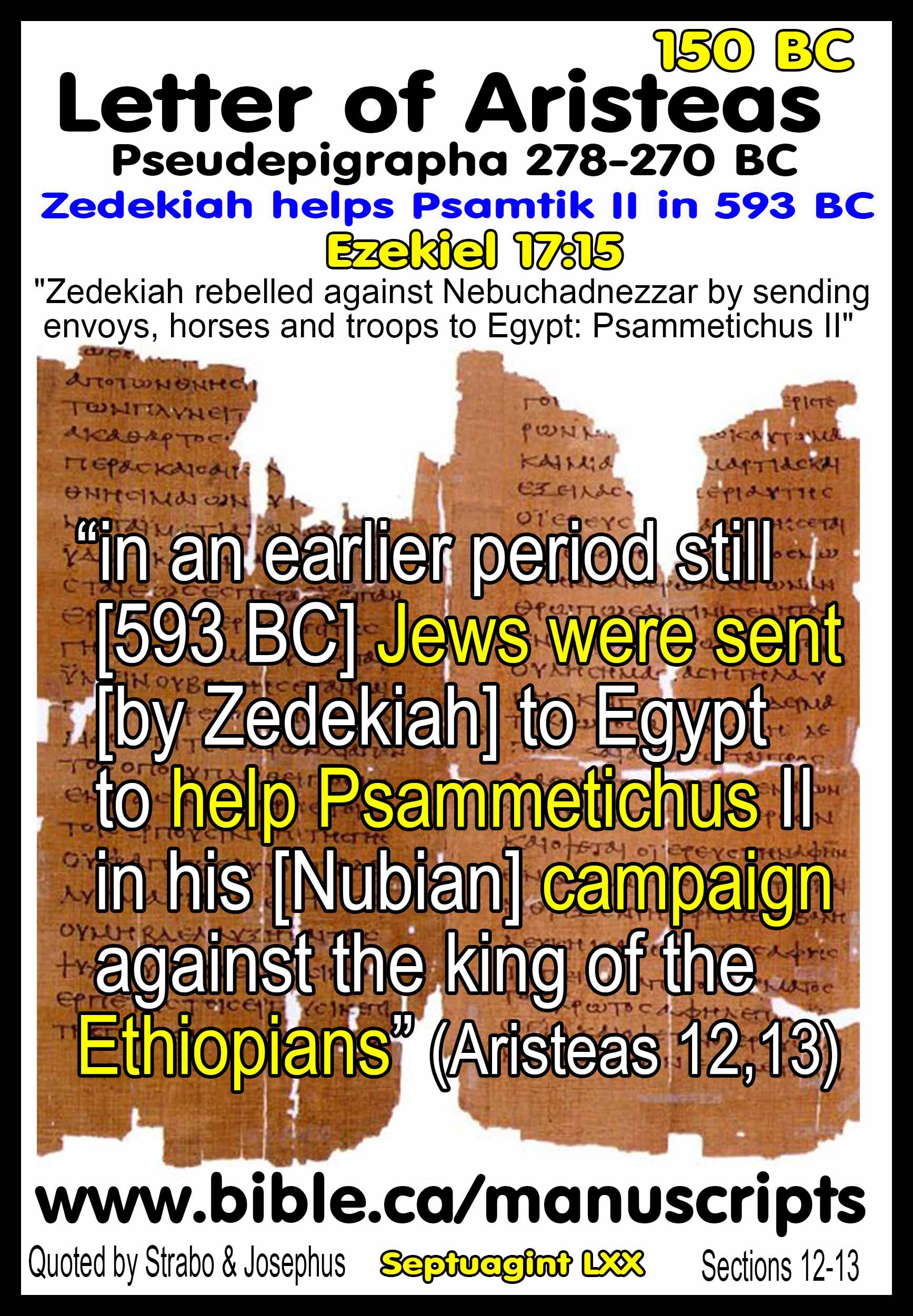
2. 593 BC: Psamtik II defeats Nubia with the help of Zedekiah
a. Nubian Victory Stele (593 BC)
b.
Translation Psamtik II Stele: "Psamtik
ever-living; valiant king, traversing two islands [Elephantine], your majesty
sent troops to Nubia, it was misery for the rebels. Not one bound pair escaped
of the 4,200 captives. A successful deed!” (Nubian
Victory Stele, Steve Rudd Adapted from Lichtheim)
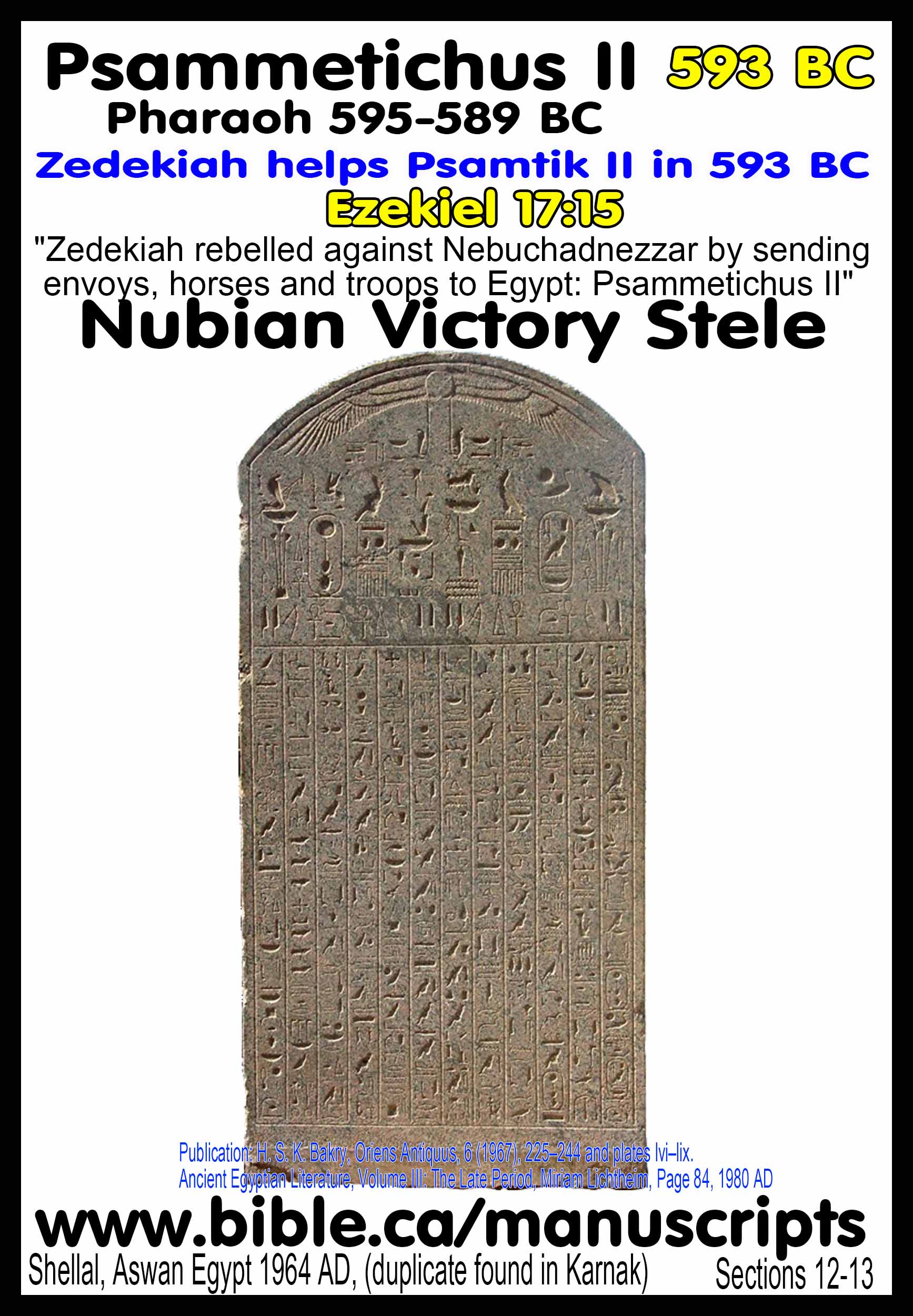
3. 593 BC: Psamtik II fortifies the Jewish colony at Elephantine established by Manasseh.
4. 592 BC: Psamtik II visits Zedekiah in the "land of Khor" (Judea, Philistia and Syria)
a. "There is evidence for military cooperation between Egypt and Judah in 593, and the following year Psammetichus II organized a triumphal visit to Palestine (Greenberg Ezekiel 1–20 AB, 13)." (ABD, Zedekiah)
b. "In 591 [Actually 592 BC] Psammetichus II (595-589) made a trip through Ḫurru (Judea, Phoenicia, Syria), which may have had as its purpose the inciting of further rebellion in Palestine [against Nebuchadnezzar]." (ABC, Volume 4, Page 1043)
c. "Following up this victory [Nubia 593 BC], Psammetichus organized a triumphal visit to Phoenicia-Palestine in 592, which cannot but have strengthened the hands of the anti-Babylonian forces in that region (W. Helck, Geschichte des alten Ägypten, Leiden: E. J. Brill, 1968, p. 254; Freedy-Redford, p. 471). Whether Zedekiah’s revolt is to be connected with that visit (Freedy-Redford, p. 480, fn. 100), or only with the accession of Pharaoh Hophra in early 589 (A. Malamat, The World History of the Jewish People, The Age of the Monarchies, IV/1 [Jerusalem: Massada, 1981], p. 215), preparations for the revolt, especially the acquisition of chariotry and auxiliaries from Egypt (cf. Ezek 17:15) must have antedated it considerably." (Ezekiel 1-20, Moshe Greenburg, p 13, 2008 AD)
d. Demotic Papyri: 414 BC:
e.
“In 4th year [592 BC] of Psamtik Nefrebre Pharaoh
is going to the land of Khor [Judea, Philistia,
Syria] Let a priest come with the bouquet of Amon to go to the
land of Khor with Pharaoh” (Catalogue of the Demotic Papyri in the John Rylands
library, F. Griffith, Francis Llewellyn, Papyrus IX, Column 15, lines 17-19, 1909
AD)
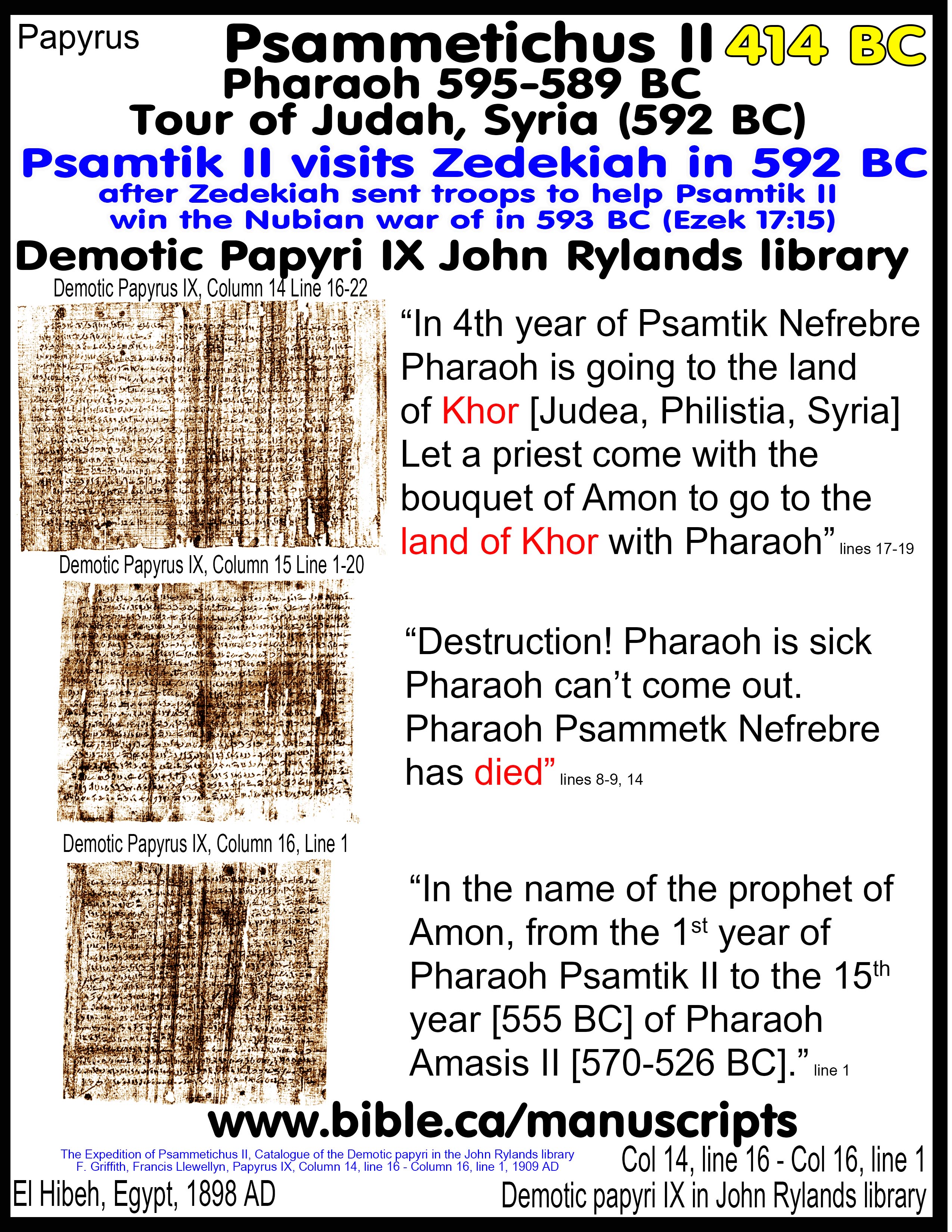
5. 592 BC: Psamtik II as one of the two eagles of Ezekiel 17
a. Ezekiel 17 was prophesied on 17 Sept 592 BC. It is amazing that while Psamtik II is visiting Zedekiah or soon after he returned to Egypt, that Ezekiel prophecy against him on 17 Sept 592!
b. "The eagle is a popular figure in the prophets as well as in the apocalyptic writings. In Ezekiel’s allegory of the eagles (Ezek. 17:1–21) a great eagle represents the Babylonian Nebuchadnezzar, and another eagle stands for the Egyptian pharaoh Psammetichus II." (Eerdmans Bible Dictionary, Eagle, 1975 AD)
c. The first eagle is Nebuchadnezzar: "Now the word of the Lord came to me saying, “Son of man, propound a riddle and speak a parable to the house of Israel, saying, ‘Thus says the Lord God, “A great eagle [Nebuchadnezzar] with great wings, long pinions and a full plumage of many colors came to Lebanon and took away the top of the cedar. “He plucked off the topmost of its young twigs and brought it to a land of merchants; he set it in a city of traders. “He also took some of the seed of the land and planted it in fertile soil. He placed it beside abundant waters; he set it like a willow. “Then it sprouted and became a low, spreading vine with its branches turned toward him, but its roots remained under it. So it became a vine and yielded shoots and sent out branches." (Ezekiel 17:1-6)
d. The second eagle is Psamtik II: “But there was another great eagle [Psamtik II] with great wings and much plumage; and behold, this vine bent its roots toward him and sent out its branches toward him from the beds where it was planted, that he might water it. “It was planted in good soil beside abundant waters, that it might yield branches and bear fruit and become a splendid vine.” ’ “Say, ‘Thus says the Lord God, “Will it thrive? Will he not pull up its roots and cut off its fruit, so that it withers—so that all its sprouting leaves wither? And neither by great strength nor by many people can it be raised from its roots again. “Behold, though it is planted, will it thrive? Will it not completely wither as soon as the east wind strikes it—wither on the beds where it grew?" (Ezekiel 17:7-10)
e. Condemnation of Zedekiah: The interpretation of the two eagles: "Moreover, the word of the Lord came to me, saying, “Say now to the rebellious house, ‘Do you not know what these things mean?’ Say, ‘Behold, the king of Babylon came to Jerusalem, took its king and princes and brought them to him in Babylon. ‘He took one of the royal family and made a covenant with him, putting him under oath. He also took away the mighty of the land, that the kingdom might be in subjection, not exalting itself, but keeping his covenant that it might continue. ‘But he [Zedekiah] rebelled against him [Nebuchadnezzar] by sending his envoys to Egypt [Psamtik II] that they might give him horses and many troops. Will he succeed? Will he who does such things escape? Can he indeed break the covenant and escape? ‘As I live,’ declares the Lord God, ‘Surely in the country of the king who put him on the throne, whose oath he despised and whose covenant he broke, in Babylon he shall die. ‘Pharaoh with his mighty army and great company will not help him in the war, when they cast up ramps and build siege walls to cut off many lives. ‘Now he despised the oath by breaking the covenant, and behold, he pledged his allegiance, yet did all these things; he shall not escape.’” Therefore, thus says the Lord God, “As I live, surely My oath which he despised and My covenant which he broke, I will inflict on his head. “I will spread My net over him, and he will be caught in My snare. Then I will bring him to Babylon and enter into judgment with him there regarding the unfaithful act which he has committed against Me. “All the choice men in all his troops will fall by the sword, and the survivors will be scattered to every wind; and you will know that I, the Lord, have spoken.” Thus says the Lord God, “I will also take a sprig from the lofty top of the cedar and set it out; I will pluck from the topmost of its young twigs a tender one and I will plant it on a high and lofty mountain. “On the high mountain of Israel I will plant it, that it may bring forth boughs and bear fruit and become a stately cedar. And birds of every kind will nest under it; they will nest in the shade of its branches. “All the trees of the field will know that I am the Lord; I bring down the high tree, exalt the low tree, dry up the green tree and make the dry tree flourish. I am the Lord; I have spoken, and I will perform it.”" (Ezekiel 17:11-24)
f. "Significantly, the change in Zedekiah’s disposition toward Nebuchadrezzar appears to have coincided with the accession of Psammetichus II 595–589) to the throne of Egypt. A papyrus [Demotic Papyri, 414 BC] from El Hibeh refers to a visit by the pharaoh to Syria-Palestine in his fourth year, ostensibly as a religious pilgrimage to Byblos. But such royal visits usually also have political undertones, especially since these states had revolted against Babylon as recently as three years previously. In an early second-century B.C. letter to Philocrates, Aristeas [Letter of Aristeas, 12-13, 150 BC] recalls that under Psammetichus, Jews had assisted the Egyptians in their conflicts with the Ethiopians (Ep. Aristeas 13). It is not clear whether Psammetichus II encouraged Zedekiah to revolt again in 588. During the ensuing siege of Jerusalem, the Judeans looked to Psammetichus II’s successor, Apries/Hophra 589–570), for aid (cf. Jer. 37:5–7), but in vain. Egypt stood by and watched the razing of its former ally’s capital without taking up arms in its defense. This brief survey of events leading up to the siege of Jerusalem demonstrates that Zedekiah’s pro-Egyptian policy was not a last-minute strategy of desperation. He had been casting his eyes southward for several years." (NICOT, Ezekiel 17:14-15)
g. "The allegory in Ezekiel 17:1–10 presupposes the conspiracy of Judah with Egypt and Zedekiah’s defection from Babylonian overlordship implicit in it. Greenberg has put together the accounts which appear to support an intervention of Psammetichus II (594–588) in Palestine. The Babylonian reaction, according to Ezek 17:1–9, has still not taken place. So we are led to the time before the beginning of the siege of Jerusalem (cf. 24:1f*)." (Hermeneia, Ezekiel 17:1–24, 1979 AD)
h. "Although Ezekiel’s original audience would have immediately understood the allegory, God nevertheless provides an oracular interpretation of it. The first eagle is Nebuchadnezzar, who deported the Israelite king Jehoiachin and Ezekiel’s fellow exiles to Babylon in 597 b.c. Nebuchadnezzar then placed the Davidide Zedekiah on the throne in Jerusalem and made a treaty with him, thus providing all the conditions necessary for political stability in the land. However, Zedekiah rebelled and sought military support for his revolt against the Egyptian pharaoh Psammetichus II, the second eagle of the allegory. Ezekiel, like Jeremiah (Jer. 27:4-15), considered this move not only a political blunder but also a violation of God’s will. Therefore the judgment will take place on two levels. On the human level, Nebuchadnezzar will besiege Jerusalem and deport Zedekiah to Babylon, where he will die. On the divine level, God will trap Zedekiah and judge him by taking him to Babylon, destroying his army in the process (Ezek. 11:11-21). The interpretation of the allegory is straightforward and, for the most part, does not appear to have been crafted after the fall of Jerusalem. In fact Nebuchadnezzar was not able to capture Jerusalem easily (cf. v. 9)." (Harper’s Bible Commentary, Ezekiel 17:11, 1988 AD)
i. "Ezekiel depicts the same event with the eagle to be understood allegorically. The eagle’s carrying off the top shoot of a tree (17:3–4a) represents King Nebuchadrezzar, who removes the Davidic house and King Jehoiachin and exiles the ruling elite to Babylon. In 17:7, Ezekiel uses the image of the eagle for another king, “another great eagle with great wings and much plumage.” This eagle is the Egyptian king, Psammetichus II, who tries to extend his power by inciting Zedekiah to rebel against Babylon. But both eagles, Nebuchadrezzar and Psammetichus II, come to nought in God’s purposes (17:22–24). Working in a similar paradigm of imperial powers as agents of God’s judgment who will in turn be judged by God, various prophets also use the image of the eagle to depict aspects of these empires: their power, leaders,31 and impact. In these ten passages, the eagle either depicts an imperial power (Assyria, Babylon, Egypt), or represents an aspect of imperial power. Further, God emerges in Ezek 17:22–24 (cf. 17:3–4) as a supereagle who, after using an imperial power to inflict punishment, now punishes the imperial power and saves the people from Babylon. Six passages explicitly use the eagle to depict God’s salvation from imperial tyrants. God saves from Egypt: “You have seen what I did to the Egyptians, and how I bore you on eagles’ wings and brought you to myself” (Exod 19:4; cf. Deut 32:10–11). God also saves from Babylon (Isa 40:31) and from Moab, which exploits Babylon’s presence to threaten Judah (Jer 30:10, 16 LXX = 49:16, 22). In “out-eagling” these imperial powers, God soars even “among the stars” to destroy Edom (Obad 1:4)." (Journal of Biblical Literature, Volume 122, p 473, 2003 AD)
6. January 589 BC: Nebuchadnezzar arrives at Jerusalem and begins the siege that will last until July 587 BC.
7. 589 BC: Psamtik II finally dies after withering away on a sick bed:
a. "Will it [eagle, Psamtik II, Egypt] thrive? Will he not pull up its roots and cut off its fruit, so that it withers—so that all its sprouting leaves wither? And neither by great strength nor by many people can it be raised from its roots again. “Behold, though it is planted, will it thrive? Will it not completely wither as soon as the east wind strikes it—wither on the beds where it grew?" (Ezekiel 17:7-10)
b. Herodotus: "Psammis [Psammetichus II] reigned over Egypt for only six years; he invaded Ethiopia, and immediately thereafter died, and Apries the son of Psammis reigned in his place." (Herodotus, Hist. 2.160.1)
c. “Destruction! Pharaoh is sick Pharaoh can’t come out. Pharaoh Psammetk Nefrebre has died” (Catalogue of the Demotic Papyri in the John Rylands library, F. Griffith, Francis Llewellyn, Papyrus IX, Column 16, lines 8-9, 14, 1909 AD)
d. Fulfilling Ezekiel 17:7-10 Psamtik II gets sick and is bedridden until he finally dies.
e. Hophra, the son of Psamtik II was likely co-regent or already functioning as king while his bed lay bedridden.
|
|
|
|
Hophra (Apries): 589-570 BC 1. 589 BC: Hophra sends support to Zedekiah's rebellion to Nebuchadnezzar a. "Meanwhile, Pharaoh’s [Hophra] army had set out from Egypt; and when the Chaldeans who had been besieging Jerusalem heard the report about them, they lifted the siege from Jerusalem. Then the word of the Lord came to Jeremiah the prophet, saying, “Thus says the Lord God of Israel, ‘Thus you are to say to the king of Judah, who sent you to Me to inquire of Me: “Behold, Pharaoh’s army which has come out for your assistance is going to return to its own land of Egypt. “The Chaldeans will also return and fight against this city, and they will capture it and burn it with fire.” ’" (Jeremiah 37:5-8, 589 BC) |
|
2. 570 BC: Nebuchadnezzar kills Hophra in Jer 44:30
a. "Thus says the Lord, ‘Behold, I am going to give over Pharaoh Hophra king of Egypt to the hand of his enemies, to the hand of those who seek his life, just as I gave over Zedekiah king of Judah to the hand of Nebuchadnezzar king of Babylon, who was his enemy and was seeking his life.’ ”" (Jeremiah 44:30)
|
|
|
|
Amoses II (Amasis) 570-526 BC 1. Named after the 18th dynasty pharaohs of the Exodus c. Moses was the adopted son of these Pharaohs: MOSES, ThutMOSES II (adopted father), ThutMOSES III (adopted brother) d. Pharaoh who killed Hebrew children: Amunhotep I: 1532-1511 BC e. Pharaoh's Daughter who adopted Moses: Hatshepsut: 1526 BC f. Pharaoh of Moses' flight to Midian: Thutmoses II/Hatshepsut: 1498-1485 BC g. Pharaoh of the Exodus: Thutmoses III: 1485/1464 - 1431 BC h. See more about the Pharaohs of the exodus in 1446 BC |
|
2. After Nebuchadnezzar defeated Hophra according the prophecy, Egypt played an insignificant role in Judah's history until the time of after Alexander the Great under the Greek empire:
a. Alexander the great ruled died in 333-323 BC
b. After Alexander the Great died in 323 BC, his kingdom split into four kingdoms, one of which was founded by Egyptian Ptolemy.
c. The Ptolemaic empire controlled Judah 323 - 31 BC with the exception of the brief period of Judean independence between 110 - 37 BC under the Maccabees.
d. Mark Anthony kills Antigonus in 37 BC, extincting the Hasmonean/Maccabean kingdom of Judah.
e. The Ptolemaic kingdom was conquered by the Romans in 31 BC when Octavian (Augustus) defeated Mark Anthony and Cleopatra at the battle of Actium.
f. The Egyptian Ptolemaic empire was made extinct, when Mark Anthony and Cleopatra committed suicide in 30 BC.
g. Rome now ruled the world and Jesus Christ was born in 2 BC, where Herod the great died in 1 BC.
3.
Most of Amoses II's rule was during the time when Judah
was in "Al-Yahudaia", the Jewish
colony in Babylon 605-536 BC.
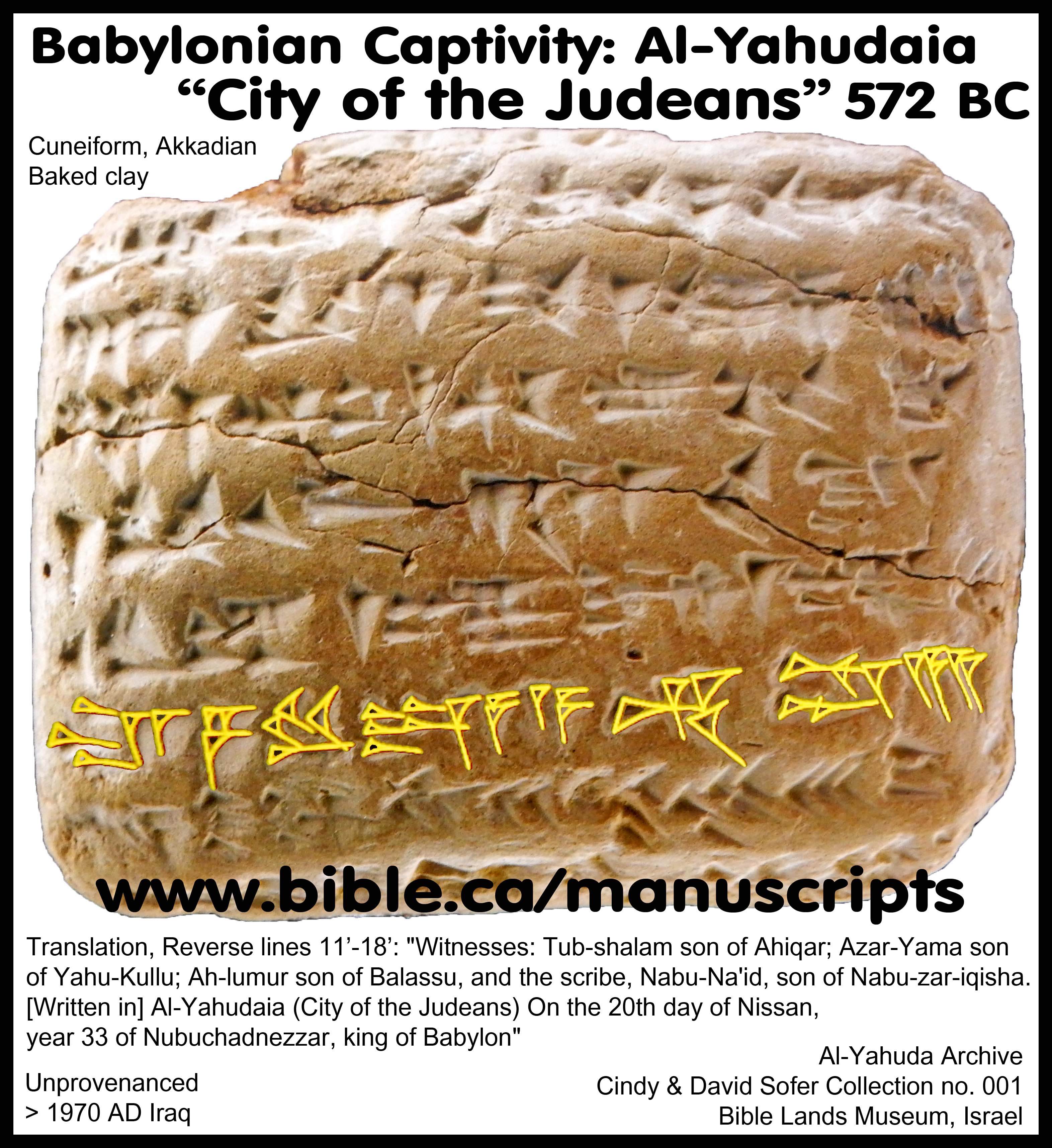
a. Al-Yahudaia (City of the Judeans) was not Jerusalem in Judea but a brand new colony city set up by Nebuchadnezzar in 605 BC!
b.
BLESSINGS OF JERUSALEM TRANSFERRED TO Jewish colony in
Babylon called "Al-Yahudaia" in 605
BC. This swapping of blessings and curses between Babylon and Jerusalem are
seen in the book of Revelation. Every time you read "Babylon" in
Revelation, it is literally "Jerusalem" which was to be destroyed in
70 AD. This firmly and unquestionably dates Revelation to 66 AD.
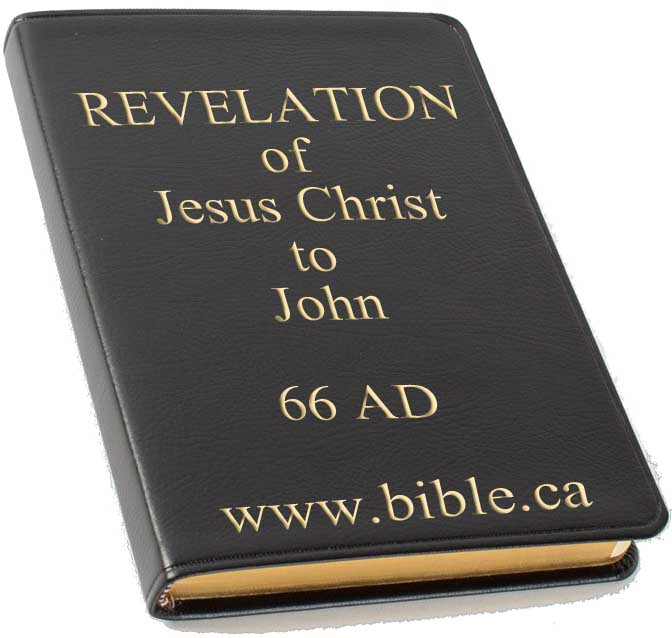
4. 586 BC: Nebuchadnezzar fully subdues Egypt: Jer 44:30
a. "Thus says the Lord, ‘Behold, I am going to give over Pharaoh Hophra king of Egypt to the hand of his enemies, to the hand of those who seek his life, just as I gave over Zedekiah king of Judah to the hand of Nebuchadnezzar king of Babylon, who was his enemy and was seeking his life.’ ”" (Jeremiah 44:30)
Conclusion:
- The promised land had two great world powers it always had to contend with: Egypt and Assyria/Babylon
- God used these world powers to bring about his will.
- What we read in the book, we find in the ground.
By Steve Rudd: Contact the author for comments, input or corrections.
